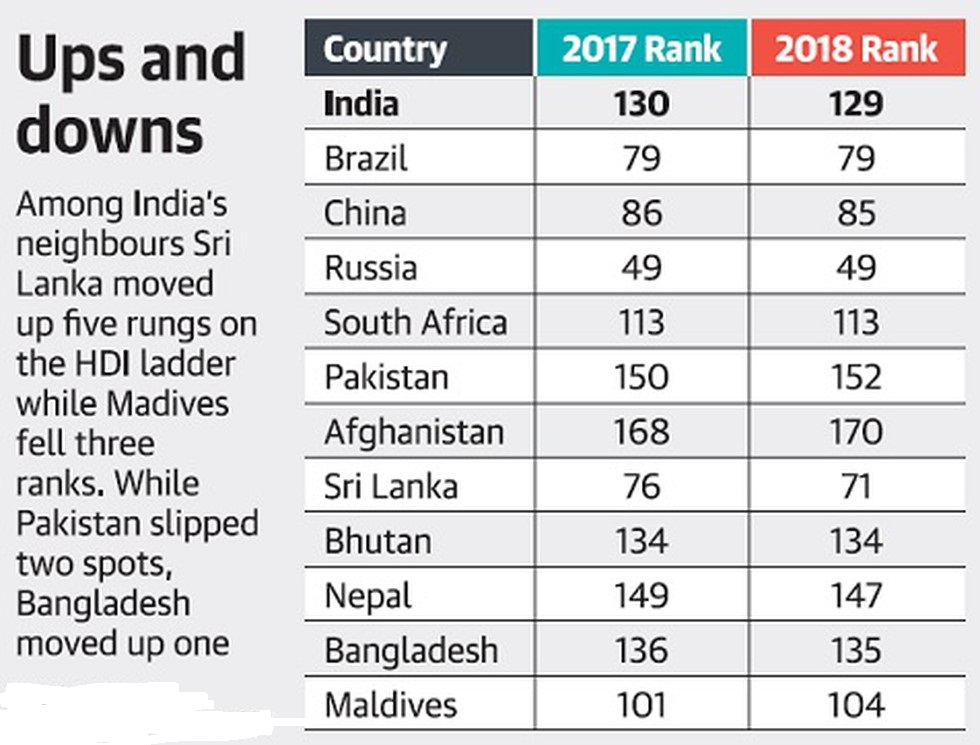Human Development Index | 10 Dec 2019
Why in News
India was ranked 129 out of 189 countries on the 2019 Human Development Index (HDI) improving from the 130th position in 2018.
- HDI is part of the Human Development Report that is published by the United Nations Development Programme (UNDP).
- The other indices that form the part of the 2019 Report are:
- Inequality-adjusted Human Development Index (IHDI),
- Gender Development Index (GDI),
- Gender Inequality Index (GII) and
- Multidimensional Poverty Index (MPI).
- The focus of the 2019 Report is on ‘Inequality in Human Development’.
Human Development Index
- HDI emphasizes that people and their capabilities should be the ultimate criteria for assessing the development of a country, not economic growth alone.
- HDI measures average achievement of a country in three basic dimensions of human development:
- A long and healthy life,
- Access to knowledge, and
- A decent standard of living.
- Top Performers in 2019
- Norway, Switzerland, Ireland occupied the top three positions in that order.
- Germany is placed fourth along with Hong Kong, and Australia secured the fifth rank on the global ranking.
- India’s Neighbours

- Sri Lanka (71) and China (85) were higher up the rank scale.
- Bhutan (134), Bangladesh (135), Myanmar (145), Nepal (147), Pakistan (152) and Afghanistan (170) were ranked lower on the list.
- Region Wise Performance
- South Asia was the fastest growing region in human development progress witnessing a 46% growth over 1990-2018, followed by East Asia and the Pacific at 43%.
- India’s Performance
- India’s HDI value increased by 50% (from 0.431 to 0.647), which places it above the average for other South Asian countries (0.642).
- In India, between 1990 and 2018, life expectancy at birth increased by 11.6 years, mean years of schooling increased by 3.5 years and expected years of schooling increased by 4.7 years. Per capita incomes rose by over 250%.
Inequality-adjusted Human Development Index
- The IHDI indicates percentage loss in HDI due to inequality.
- India’s position worsened by one position to 130 (as compared to the HDI Index 2019- 129) with a score of 0.477. Although, the IHDI score has improved from 0.468 in 2018.
Gender Development Index
- GDI measures disparities on the HDI by gender.
- India is only marginally better than the South Asian average on the Gender Development Index (0.829 vs 0.828).
Gender Inequality Index
- GII presents a composite measure of gender inequality using three dimensions:
- Reproductive health,
- Empowerment and
- The labour market.
- In GII, India is at 122 out of 162 countries. Neighbours China (39), Sri Lanka (86), Bhutan (99), Myanmar (106) were placed above India.
- The report noted that group-based inequalities persist, especially affecting women and girls and no place in the world has gender equality.
- The report notes that the world is not on track to achieve gender equality by 2030 as per the UN’s Sustainable Development Goals (SDG -5). It forecasts that it may take 202 years to close the gender gap in economic opportunity.
- The report presents a new “social norms index” indicating how prejudices and social beliefs obstruct gender equality, which shows that only 14% of women and 10% of men worldwide have no gender bias.
- The report highlights that new forms of inequalities will manifest in future through climate change and technological transformation which have the potential to deepen existing social and economic fault lines.
Multidimensional Poverty Index
- MPI captures the multiple deprivations that people in developing countries face in their health, education and standard of living.
- India accounts for 28% of the 1.3 billion multidimensional poor.
